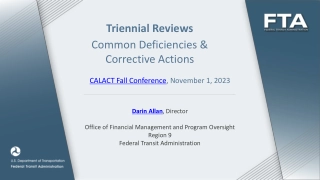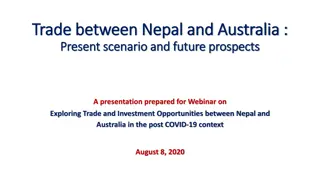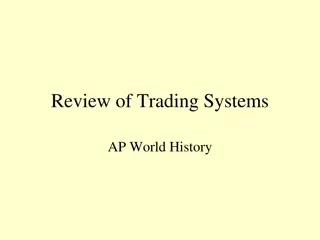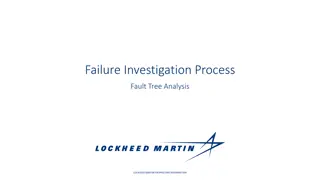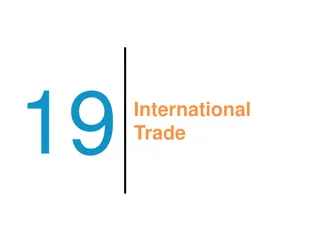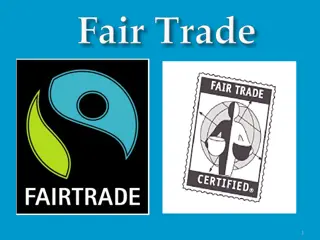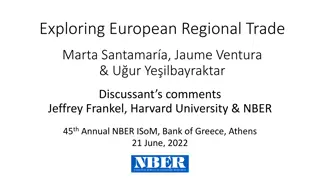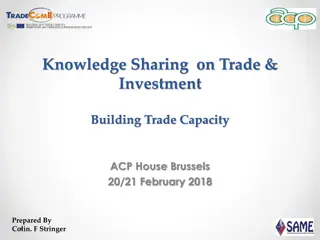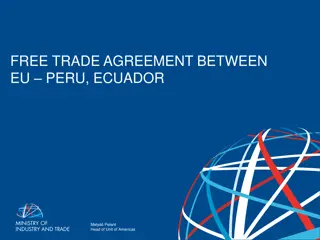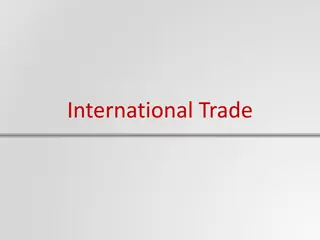
Korea's FTA Evolution & Effects on Trade
The evolution of Korea's FTA strategies from overcoming the 1997 financial crisis to expanding trade networks with various countries, including with the EU. Analysis of Korea-EU FTA effects on trade relations and notable trends in bilateral trade with the EU.
Download Presentation

Please find below an Image/Link to download the presentation.
The content on the website is provided AS IS for your information and personal use only. It may not be sold, licensed, or shared on other websites without obtaining consent from the author. If you encounter any issues during the download, it is possible that the publisher has removed the file from their server.
You are allowed to download the files provided on this website for personal or commercial use, subject to the condition that they are used lawfully. All files are the property of their respective owners.
The content on the website is provided AS IS for your information and personal use only. It may not be sold, licensed, or shared on other websites without obtaining consent from the author.
E N D
Presentation Transcript
Koreas FTA strategies & Effects of Korea-EU FTA 1
Koreas FTA strategy began ten years ago FTA 1.0 Korea chose FTA as major growth engine to overcome the 1997 financial crisis - Korea needed a further access to global market in order to overcome the crisis in 1997, which hit its economy very hard - Korea s decision to push forward FTA negotiations was also based on the need for further reform of its economy Korea s first FTA partner was Chile: Negotiation was completed in 2002 and agreement came into force in 2004 Korean Economy during crisis FTA negotiation with Chile began in 1999 (%) (%) 40 15 10 20 5 0 0 1990 1992 1994 1996 1998 2000 Imports growth(LH) Exports growth(LH) GDP growth rate(RH) -20 -5 -40 Source: IMF -10 2
Evolution of Koreas FTA strategy FTA 2.0 In 2003, Korean government introduced FTA Roadmap , a long term plan for future trade & investment negotiations - Indicated major FTA partners and areas for liberalisation Completed negotiations with EU and US in the late 2000s: These were key achievements of FTA Roadmap - Korea-EU FTA and Korea-US FTA came into force in 11 and 12, respectively FTA 3.0 In 2013, Korean government announced New Trade Roadmap , a new plan for the next decade - Plans to play the role of a linchpin in TPP led by US and RCEP led by China - Began FTA negotiation with China, participated in RCEP negotiations, and stated intention to consider joining the TPP in 2013 Plans to expand trade with resource rich countries and emerging economies - FTA negotiations were completed with Australia in 2013 and Canada in 2014 - Currently negotiating with Indonesia and Vietnam 3
Koreas FTA network in 2014 As of April, 2014, no. of Korea s FTA partner countries stands at 47 through 9 agreements in force - Chile, Singapore, EFTA, ASEAN, India, E.U., Peru, U.S., Turkey Compared to Korea s major competitors - With FTAs with the US and the EU, the share of trade with FTA partners almost trebled since 2009 to 35.3% in 2013, surpassing China and Japan - Share of home country & FTA partners GDP in the global economy is 56% for Korea, much higher than that for China(16.2%) or Japan(17.2%) Share of Home & FTA Partners GDP Share of trade with FTA Partners (%) (%, Year 2013) 40 60 Korea FTA partners 50 30 Home country 40 China Japan 20 30 20 10 10 0 0 2009 2010 2011 2012 2013 Korea China Japan Source: KITA IIT Source: KITA IIT 4
Notable trends in Korea-EU trade relations Korea EU: Motor vehicles, Cruise ships, Telephone sets, Motor parts EU Korea: Motor vehicles, Petroleum oils, Machines and apparatus, Aircrafts With a rapid rise in Korea s imports from the EU, net trade balance has turned negative Share of EU in Korea s exports is declining fast - Rise of Asian trade partners such as Vietnam and Indonesia - Eurozone fiscal crisis led to a depressed consumption market Share of Korea s exports Korea-EU trade relations (%) Exports Imports Balance (Million $) 30 70,000 China 60,000 25 50,000 20 40,000 ASEAN U.S. E.U. Japan 30,000 15 20,000 10 10,000 5 0 2005 2006 2007 2008 2009 2010 2011 2012 2013 -10,000 0 -20,000 2005 2006 2007 2008 2009 2010 2011 2012 2013 Source: KITA Source: KITA 5
There are some positive signs too Performance of Korea s exports to the EU has been disappointing since the FTA came into effect Yet it is too early to criticise the agreement and there have been economic crises in the eurozone Korea is doing well in its key export products - Out of Korea s 10 top export items to the EU, 5 items recorded an increasing share in the EU market between 2010 and 2013(Jan.~Oct.) Share of imports from Korea in EU s total external imports (%) (%) (%) (%) Precision Equipment (%) Chemical products Cruise Ships Plastic Motor vehicles 2 6 8 45 43 7 5 1.2 41 1.5 6 39 4 5 37 1 3 4 1 35 2010 2013 2010 2013 2010 2013 2010 2013 2010 2013 Source: KITA IIT 6
Products covered by Korea-EU FTA If we analyse EU s import of products covered by the Korea-EU FTA in 2013, Korea performed rather well - EU s imports from Korea decreased by 6.6% in total: while imports of products not covered by FTA decreased by 15.4%, those covered increased by 0.1% - EU s imports of products covered by Korea-EU FTA (a+b) increased by 0.1% from Korea while total imports of these products decreased by 1.7% - The performance of Korea s exports was more marked in products with tariff planned to be phase out (b) % change in EU s imports of products covered by Korea-EU FTA (2012 Jan~Oct 2013 Jan~Oct) Products with tariff Korea China Japan U.S. Extra-EU total Immediately Eliminated (a) -1.8 -1.9 -11.4 -1.8 -1.6 Phased Out (b) 5.7 -7.6 -9.5 -16.4 -2.7 Total covered by FTA (a+b) 0.1 -2.3 -11.0 -2.9 -1.7 (a+b) share of total imports 60.7 58.6 66.4 56.9 46.8 Source: KITA IIT 7
Lessons from Korea-EU FTA Governments and independent bodies should provide a balanced analysis on the effects of FTAs - e.g. Trade balance vs. Performance of exports covered by FTA Governments should continue their efforts to raise the FTA utilisation rate, with special focus on helping SMEs No. of requests to check RoO Korean exporters FTA utilization rate 300 (%) 90 Korea-EU FTA 200 80 Rest US 100 EU Korea-US FTA 70 0 60 2011 2012 2013 Jan~Sept 2011 2012 2013 Source: KITA IIT Source: Korea Customs Serivce 8
Lessons from Korea-EU FTA (contd) Participating countries firms should bare in mind that FTAs are like a marathon not a sprint Both governments and firms should be prepared for the spread of FTAs - The EU is working hard to push forward its FTA strategies EU is currently negotiating FTAs with major advanced economies such as the U.S(TTIP), Japan & emerging economies such as India, Vietnam, MERCOSUR, and Thailand EU: Share of Home & FTA Partners GDP (%) Economic growth rate (%) United Kingdom 3 Negotiating stage 80 70 60 2 50 40 Eurozone 1 Negotiations completed or near enforcement 30 20 0 10 2010 2011 2012 2013 2014 2015 0 -1 2011 2012 2013 Short term Medium to Source: IMF Source: KITA IIT long term 9

